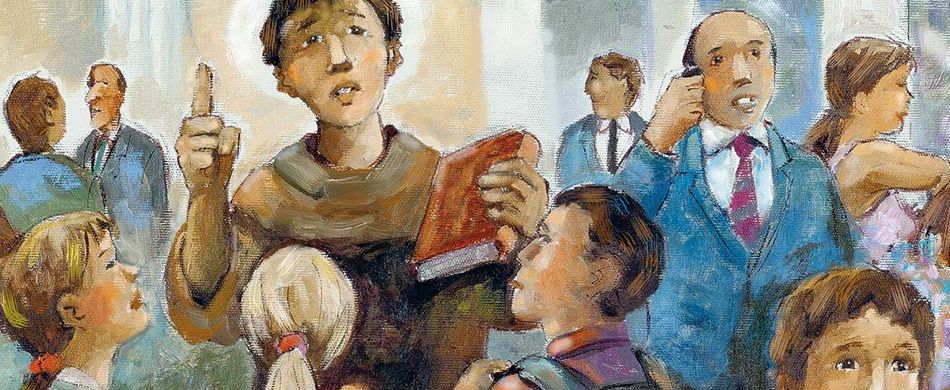Franciscan Laity
THE YEAR 2021 marks the 800th anniversary of the first papally approved Rule for the lay followers of Saint Francis.
Everyone follows a rule of life. People schedule their meals at certain times and prefer to eat certain foods. They follow work and relax at certain times. People celebrate special occasions and observe certain seasons and vacations.
A religious rule brings God into everyday life. Priests observe a religious rule. They offer at least one Mass daily. They pray the Divine Office which is a daily liturgy of Psalms, prayers, and liturgical readings. Religious, whether living in communities or out in the world, also observe a religious rule. They may pray the Divine Office. They may observe certain days of fast and abstinence. Often, they spend time daily in contemplative and/or vocal prayer. They engage in works of mercy. Some wear a specific garb.
New movement
In the mid 1100s and early 1200s, some laity in Europe began to live a religious rule of life. Father Rafaele Pazzelli, TOR, speculates that they were influenced by itinerant preachers whose ideas spread throughout the continent. The message of these preachers was: “Put God first in your life, and everything else falls into place.”
God wasn’t often in first place. Nobles vied for power. Merchants, comprising a rising middle class, were challenging the nobility. They demanded a say in governance. Some clergy and laity lived scandalous lives. Poor itinerant preachers were a holy contrast. Their faith was genuine.
Ironically, some laity who were living lives of holiness had been grave sinners who had been initiated into the canonical state of penance as restitution. These penitents wore simple, poor garb. They kept a prayer schedule. They strictly observed fast and abstinence. Some worked with the poor or hospitalized. Others embarked on pilgrimages. These canonical penitents met regularly with a member of the clergy for instruction.
Laity who wished to put God first reasoned, “If penitential practices help public sinners grow in holiness, wouldn’t these practices help me? I’m a sinner, too.”
Voluntary penitent
Spontaneously, voluntary penitents sprouted in Europe. One of these was a young merchant. This former war veteran and prisoner of war experienced a post-prison illness and long convalescence. He began to rethink his goals. Eventually he realized that none give meaning to life. Meaning comes from life’s Creator. So, Francis of Assisi became a voluntary penitent. Through him, God transformed other lives including that of Anthony of Padua.
When men began to join Francis, they became penitential role models. They helped the poor and needy. They prayed. They responded humbly to ridicule. They refused to retaliate. They exhorted people to put God first.
Men joined Francis and his followers. Women joined the female branch of this newly developing Order under Clare of Assisi, a noble woman who embraced hiddenness, humility, and poverty. But what about laity?
Three Orders
Less than ten years after Francis’ death in 1226, Brother Julian of Speyer composed a Life of Saint Francis. He drew on the first life of the saint by Brother Thomas of Celano published in 1229. While Thomas mentions the “triple army” (Chapter XV.37) of followers, Julian explains that Francis “founded three Orders… the Order of Lesser Brothers… the Order of the Poor Ladies… the Order of Penitents, which profitably brings together clerics and laity, virgins, unmarried, and married persons of both sexes” (Chapter IV.23).
Francis wrote letters to these laity, exhorting them to conversion. One from 1209-1215 and another from around 1220 are still in existence (Francis of Assisi: Early Documents I, pp. 41-51; Regis J. Armstrong, OFM Cap; J.A .Wayne Hellmann, OFM Conv; William J. Short, OFM; New City Press). Francis did not, however, write a Rule for them. That was written by the papally assigned Protector of the Order, Cardinal Ugolino. Pope Honorius III gave the Rule oral approval in 1221. Francis accepted it. He and his followers shared it with “People of all ages and both sexes” being converted by the brothers.
In 1221 Francis composed a Rule for his Order. The papacy rejected it because it was not juridical. Francis rewrote this Rule. His more juridical 1223 Rule for the brothers was accepted. This is the Rule that Franciscan male orders follow today.
Saint Dominic
Francis and his brothers were not the only ones preaching. Saint Dominic and his preaching brothers were also making converts. Apparently, the 1221 Rule for “the Brothers and Sisters of Penance” was shared with laity, no matter which Order converted them. Pazzelli writes, “Only the movement led by Francis and Dominic and their orders… could welcome Christians inspired by evangelical ideals yet wishing to remain in their homes.” “Penitents of Saint Francis” and “Penitents of Saint Dominic” were recognized as early as 1225.
Over decades, penitents diverged into more Franciscan or Dominican expressions. In 1285 the Master General of the Dominicans, Munio de Zamora, published a “Rule for the Penitents of Saint Dominic”. Several sections of de Zamora’s Rule appear to be lifted from the Rule of 1221 of the Brothers and Sisters of Penance.
In 1289 the Franciscan Pope Nicholas IV reorganized the Rule of 1221. He put the penitents directly under the Franciscans by specifying “that the visitors and instructors should be taken from the Order of Friars Minor.” The Rule underwent further revision under Pope Leo XIII in 1883 and then again under Pope Paul VI in 1978.
With Francis’ permission, Saint Anthony wrote Sermon notes for the brothers. These address penitents among others. This eleven-month series will explore penitential themes in Anthony’s notes and how they relate to the Rule of 1221 and to the current Rule of 1978 for Franciscan laity.



